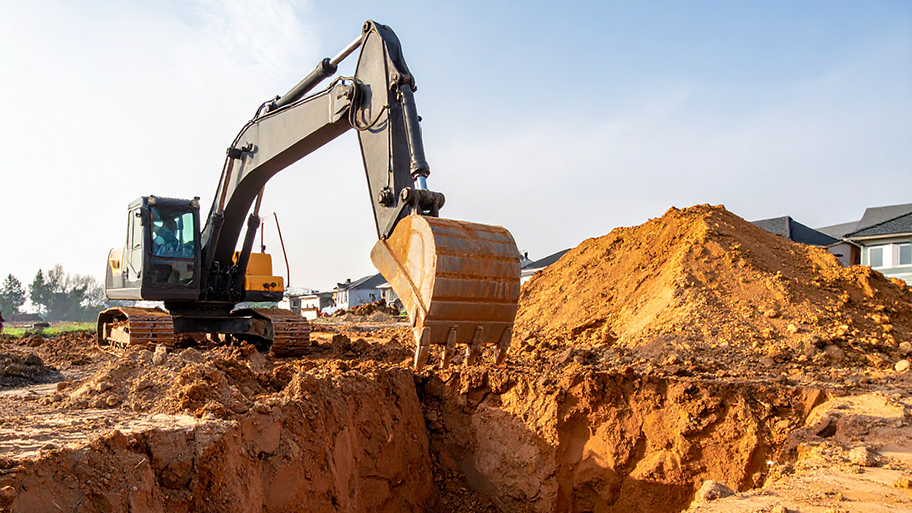
If you’re building a new home, you might need to consider the cost of digging out a basement. Use this pricing guide to get an estimate for the project.
Get dirt-ermined to succeed


It takes 10 to 12 hours to dig a 100-foot trench by hand.
Renting a trencher can reduce the time down to two to three hours.
Wet the soil the day before trenching to speed up the project.
Call the 811 dig line before trenching on your property.
Consider renting a mechanical trencher or calling a pro for long or particularly deep trenches.
Digging a trench is hard work, but it can have big payoffs, like adding electrical to a pole barn or detached garage. It takes two to 12 hours to dig a 100-foot trench, depending on your tools and the depth, width, and soil type. Learn how long it takes to dig a trench, how to speed up the process, and when to call in a pro.
It takes two to 12 hours to dig a 100-foot trench that’s 24 inches deep (the average size of a residential trench), depending on the type of trencher you use, the soil conditions, the terrain, and the depth.
Here’s how long it takes to dig a 100-foot trench (24 inches deep) by method:
By hand: 10 to 12 hours
With a walk-behind trencher: 2 to 3 hours
With a ride-on trencher: 1 to 2 hours
Many factors affect how long it takes to dig a ditch. Consider these components to estimate how long digging your trench will take.
The depth, width, and length of the trench directly impact how long it takes to dig. A 2-foot-wide trench will take almost double the time that a 1-foot-wide trench takes, and a deeper trench will take longer than a shallow one.
Soft, pliable soils, like those with high sand content, are lighter and allow you to dig faster. If you have clay, rocky, or muddy soil, the project will take longer. If the ground is frozen, expect the digging to take much longer because the cold temperatures increase the dirt’s density, making the soil almost as hard as concrete.

Digging a trench with hand tools, like shovels, pickaxes, and mattocks, takes the longest, but this can be a great method for smaller trenches. Walk-behind trenchers are significantly faster and much less labor-intensive. Ride-on trenchers are the fastest option, but it takes practice to operate them efficiently. If you have heavy or rocky soil or are digging a trench longer than 100 feet, using a walk-behind or ride-on is ideal.
If you’ve dug trenches or worked with trenching machinery before, your experience and skills will speed up the project. But if you’re new to digging, add extra time for figuring out the tools and finding your flow. Digging by hand requires some physical fitness, so plan accordingly based on your abilities. Take breaks when you need to.
If you don’t want to (or can’t) trench with a shovel or ride-on trencher, contact an excavation company near you for quotes on your project. The cost to dig a trench ranges from $5 to $12 per linear foot, depending on trench depth and soil conditions.
Before you dig a trench, you should:
Call 811 dig to mark any underground utility lines, such as electrical wires, gas lines, and pipes.
Check your local guidelines to see if you need a construction permit to dig your trench.
Choose your trencher tool.
Mark where you want to dig your trench, including if it needs a slope, like when installing a french drain.
Wet the soil for one hour in the 24 hours before digging.
Wear protective equipment, such as a hard hat and safety glasses.
Loosen the soil with a pick mattock or grub hoe.
Remove obstructions, such as large rocks.
Digging a trench by hand will take significantly longer than using heavy machinery. Manually digging a trench can create a lot of back strain and lead to exhaustion, especially if you need a very long or deep trench. Consider calling a local pro if the job seems to be too big for manual digging or you find yourself getting exhausted or straining too much after digging by hand.
The fastest way to dig a trench by hand is to:
Water the soil for one hour in the 24 hours leading up to digging.
Break up tough soil with a pick mattock or grub hoe.
Dig with a trenching shovel that has a sharp tip and a long head.
Monitor the depth, slope, and line of the trench throughout digging to ensure you’re creating the pathway you need.
From average costs to expert advice, get all the answers you need to get your job done.

If you’re building a new home, you might need to consider the cost of digging out a basement. Use this pricing guide to get an estimate for the project.

Excavation costs $1,500 to $6,300 for most residential projects—but it depends on factors like the size of the area. This guide will help you plan a budget.

If you need to dig a trench, you might be tempted to do it yourself instead of hiring a pro. So, how much does it cost to rent a trencher? Let’s break it down.

Who can dig a trench for you? You can rent trenching equipment for a simple job, but a local excavation company can help with tough ones. Here's how.

Trenching is simpler and boring is best for complex properties. Learn all about boring versus trenching and when to use each.

Can you excavate in the winter? Sometimes, but it’s complicated. Find out the pros, cons, and steps for planning a winter excavation project.